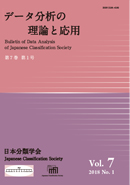Current issue
Displaying 1-4 of 4 articles from this issue
- |<
- <
- 1
- >
- >|
Special Issue
-
Article type: Special Issue
2024Volume 13Issue 1 Pages 1-3
Published: September 01, 2024
Released on J-STAGE: October 30, 2024
Download PDF (575K) Full view HTML
Article
-
Article type: Article
2024Volume 13Issue 1 Pages 5-15
Published: September 01, 2024
Released on J-STAGE: October 30, 2024
Download PDF (825K) Full view HTML -
Article type: Article
2024Volume 13Issue 1 Pages 17-29
Published: September 01, 2024
Released on J-STAGE: October 30, 2024
Download PDF (1214K) Full view HTML -
Article type: Article
2024Volume 13Issue 1 Pages 31-44
Published: September 01, 2024
Released on J-STAGE: October 30, 2024
Download PDF (1809K) Full view HTML
- |<
- <
- 1
- >
- >|
